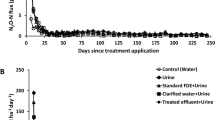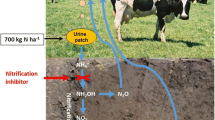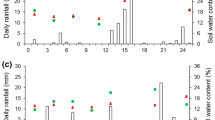Abstract
Applications of dairy farm effluents to land may lead to ammonia (NH3) volatilization and nitrous oxide (N2O) emissions. Nitrogen (N) transformation process inhibitors, such as urease inhibitors (UIs) and nitrification inhibitors (NIs), have been used to reduce NH3 and N2O losses derived from agricultural N sources. The objective of this study was to examine the effects of amending dairy effluents with UI (N-(n-butyl) thiophosphoric triamide (NBTPT)) and NI (dicyandiamide (DCD)) on NH3 and N2O emissions. Treatments included either fresh or stored manure and either fresh or stored farm dairy effluent (FDE), with and without NBTPT (0.25 g kg−1 N) or DCD (10 kg ha−1), applied to a pasture on a free-draining volcanic parent material soil. The nutrient loading rate of FDE and manure, which had different dry matter contents (about 2 and 11 %, respectively) was 100 kg N ha−1. Application of manure and FDE led to NH3 volatilization (15, 1, 17 and 0.4 % of applied N in fresh manure, fresh FDE, stored manure and stored FDE, respectively). With UI (NBTPT), NH3 volatilization from fresh manure was significantly (P < 0.05) decreased to 8 % from 15 % of applied N, but the UI did not significantly reduce NH3 volatilization from fresh FDE. The N2O emission factors (amount of N2O–N emitted as a percentage of applied N) for fresh manure, fresh FDE and stored FDE were 0.13 ± 0.02, 0.14 ± 0.03 and 0.03 ± 0.01 %, respectively. The NI (DCD) was effective in decreasing N2O emissions from stored FDE, fresh FDE and fresh manure by 90, 51 and 46 % (P < 0.05), respectively. All types of effluent increased pasture production over the first 21 days after application (P < 0.05). The addition of DCD resulted in an increase in pasture production at first harvest on day 21 (P < 0.05). This study illustrates that UIs and NIs can be effective in mitigating NH3 and N2O emissions from land-applied dairy effluents.







Similar content being viewed by others
References
Akiyama H, Morimoto S, Hayastu M, Hayakawa A, Studo S, Yagi K (2013) Nitrification, ammonia-oxidizing communities, and N2O and CH4 fluxes in an imperfectly drained agricultural field fertilized with coated urea with and without dicyandiamide. Biol Fertil Soils 49:213–223
Amberger A (1989) Research on dicyandiamide as a nitrification inhibitor and future outlook. Commun Soil Sci Plant Analysis 20:1933–1955
Aulakh MS, Rennie DA, Paul EA (1984) Acetylene and N-serve effects upon N2O emissions from NH4 + and NO3 − treated soils under aerobic and anaerobic conditions. Soil Bio Biochem 16:351–356
Bolan NS, Saggar S, Luo J, Bhandral R, Singh J (2004) Gaseous emissions of nitrogen from grazed pastures: processes, measurements and modelling, environmental implications, and mitigation. Adv Agron 84:37–120
Bremner JM, Blackmer AM (1981) Effect of nitrapyrin on emission of nitrous oxide from soil fertilized with anhydrous ammonia. Geophys Res Lett 8:353–356
Bronson KF, Mosier AR, Bishnoi SR (1992) Nitrous oxide emissions in irrigated corn as affected by nitrification inhibitors. Soil Sci Soc America J 56:161–165
Chadwick DR, Pain BF, Brookman SKE (2000) Nitrous oxide and methane emissions following application of animal manures to grassland. J Environ Qual 29:277–287
Danielson RE, Sutherland PL (1986) Porosity. In: Klute A (ed) Methods of soil analysis. Part 1. Physical and mineralogical methods. Am Soc Agron Inc, Madison, pp 443–461
Dawar K, Zaman M, Rowarth JS, Blennerhassett JD, Turnbull MH (2011) Urea hydrolysis and lateral and vertical movement in soil: effects of urease inhibitor and irrigation. Biol Fert Soils 47:139–146
de Klein CAM, Cameron KC, Di HJ, Rys G, Monaghan RM, Sherlock RR (2011) Repeated annual use of the nitrification inhibitor dicyandiamide (DCD) does not alter its effectiveness in reducing N2O emissions from cow urine. Anim Feed Sci Tech 166:480–491
Di HJ, Cameron KC (2006) Nitrous oxide emissions from two dairy pasture soils as affected by different rates of a fine particle suspension nitrification inhibitor, dicyandiamide. Biol Fert Soils 42:472–480
Di HJ, Cameron KC (2012) How does the application of different nitrification inhibitors affect nitrous oxide emissions and nitrate leaching from cow urine in grazed pastures? Soil Use Manage 28:54–61
Goodroad LL, Keeney DR (1984) Nitrous oxide production in aerobic soils under varying pH, temperature and water content. Soil Bio Biochem 16:39–43
Halvorson AD, Grosso SJ, Jantalia CP (2011) Nitrogen source effects on soil nitrous oxide emissions from strip-till corn. J Environ Qual 40:1775–1786
Hatch D, Trindade H, Cardenas L, Carneiro J, Hawkins J, Scholefield D, Chadwick D (2005) Laboratory study of the effects of two nitrification inhibitors on greenhouse gas emissions from a slurry-treated arable soil: impact of diurnal temperature cycle. Biol Fert Soils 41:225–232
Haynes RJ, Williams PH (1993) Nutrient cycling and soil fertility in the grazed pasture ecosystem. Adv Agron 49:119–199
Hewitt AE (1993) Methods and rationale of the New Zealand soil classification. Landcare Research Science Series No 2. Manaaki Whenua Press: Lincoln, NZ
Hutchinson GL, Brams EA (1992) Nitric oxide versus nitrous oxide emissions from an ammonium ion-amended Bermuda grass pasture. J Geophys Res 97:9889–9896
Kelliher FM, Clough TJ, Clark H, Rys G, Sedcole JR (2008) The temperature dependence of dicyandiamide (DCD) degradation in soils: a data synthesis. Soil Bio Biochem 40:1878–1882
Kim D, Saggar S, Roudier P (2012) The effect of nitrification inhibitors on soil ammonia emissions in nitrogen managed soils: a meta-analysis. Nutr Cycl Agroecosys 93:51–64
Kissel DE, Brewer HL, Arkin GF (1977) Design and test of a field sampler for ammonia volatilization. Soil Sci Soci America J 41:1133–1138
Linquist BA, Adviento-Borbe MA, Pittelkow CM, Kessel CV, Groenigen KJV (2012) Fertilizer management practices and greenhouse gas emissions from rice systems: a quantitative review and analysis. Field Crop Res 135:10–21
Lockman RB, Storer DA (1990) Soil nitrate and ammonium variation with area and date sampled. Commun Soil Sci Plant Anal 21:2219–2226
Luo J, Tillman RW, Ball PR (1999) Factors regulating denitrification in a soil under pasture. Soil Bio Biochem 31(6):913–927
Luo J, Ledgard S, Lindsey S (2007) Nitrous oxide emissions from application of urea on New Zealand pasture. New Zeal J Agr Res 50:1–11
Luo J, Saggar S, Bhandral R, Bolan N, Ledgard S, Lindsey S, Sun W (2008) Effects of irrigating dairy-grazed grassland with farm dairy effluent on nitrous oxide emissions. Plant Soil 309:119–130
Luo J, de Klein C, Shepherd M, Ledgard S (2010) Effect of nitrification inhibitor on nitrous oxide emissions in pasture soils. In Proc. 19th word international union of soil sciences, soil solutions for a changing world, Brisbane, Australia, 1–6 August 2010, pp 1–6. International Union of Soil Sciences (IUSS), c/o Institut für Bodenforschung, Universität für Bodenkultur
Luo J, Ledgard SF, Lindsey SB (2013) Nitrous oxide and greenhouse gas emissions from grazed pastures as affected by use of nitrification inhibitor and restricted grazing regime. Sci Total Environ. doi:10.1016/j.scitotenv.2012.12.075
Merino P, Estavillo JM, Graciolli LA, Pinto M, Lacuesta M, Munoz-Rueda A, Gonzalez-Murua C (2002) Mitigation of N2O emissions from grassland by nitrification inhibitor and Actilith F2 applied with fertilizer and cattle slurry. Soil Use Manage 18:135–141
Panetta DM, Powers WJ, Lorimor JC (2005) Management strategy impacts on ammonia volatilization from swine manure. J Environ Qual 34:1119–1130
Prasad R, Power JF (1995) Nitrification inhibitors for agriculture, health, and the environment. Adv Agron 54:233–281
Robertson GP, Tiedje JM (1987) Nitrous oxide sources in aerobic soils; nitrification, denitrification and other biological processes. Soil Biol Biochem 19:187–193
Rochette P, Angers DA, Chantigny MH, MacDonald JD, Gasser MO, Bertrand N (2009) Reducing ammonia volatilization in a no-till soil by incorporating urea and pig slurry in shallow bands. Nutr Cycl Agroecosys 84:71–80
Rotz CA (2004) Management to reduce nitrogen losses in animal production. J Anim Sci 82:E119–E137
Saggar S, Bolan NS, Bhandral R, Hedley CB, Luo J (2004) A review of emissions of nethane, ammonia, and nitrous oxide from animal excreta depostion and farm effluent application in grazed pasture. New Zeal J Agr Res 47:513–544
Saggar S, Luo J, Kim DG, Jha N (2011) Intensification in pastoral farming: impacts on soil attributes and gaseous emissions. In: Singh BP, Cowie A, Chan Y (eds) Soil health and climate change (Soil Biology Series). Springer, Berlin, pp 207–236
Saggar S, Jha N, Deslippe J, Bolan NS, Luo J, Giltrap DL, Kim D-G (2012) Denitrification and N2O:N2 production in temperate grasslands: processes, measurements, modelling and mitigating negative impacts. Sci Total Environ. doi:10.1016/j.scitotenv.2012.11.050
Sanz-Cobena A, Sánchez-Martín L, García-Torres L, Vallejo A (2012) Gaseous emissions of N2O and NO and NO3 − leaching from urea applied with urease and nitrification inhibitors to a maize (Zea mays) crop. Agri Ecosys Environ 149:64–73
Schilke-Gartley K, Sims J (1993) Ammonia volatilization from poultry manure-amended soil. Biol Fert Soils 16:5–10
Schils RLM, Eriksen J, Ledgard SF, Vellinga TV, Kuikman PJ, Luo J, Petersen SO, Velthof GL (2013) Strategies to mitigate nitrous oxide emissions from herbivore production systems. Animal 7:29–40
Sharpley A, Meisinger J, Breeuwsma A, Sims J, Daniel T, Schepers J (1998) Impacts of animal manure management on ground and surface water quality. Animal waste utilization: effective use of manure as a soil resource. Ann Arbor Press, Chelsea, pp 173–242
Shepherd M, Wyatt J, Welten B (2012) Effect of soil type and rainfall on dicyandiamide concentrations in drainage from lysimeters. Soil Res 50:67–75
Sherlock RR, Goh KM (1985) Dynamics of ammonia volatilization from simulated urine patches and aqueous urea applied to pasture. II. Theoretical derivation of a simplified model. Fert Res 6:3–22
Smith KA, Charles DR, Moorhouse D (2000) Nitrogen excretion by farm livestock with respect to land spreading requirements and controlling nitrogen losses to ground and surface waters. Part 2: pigs and poultry. Bioresource Technol 71:183–194
Sommer SG, Olesen JE (1991) Effects of dry matter content and temperature on ammonia loss from surface-applied cattle slurry. J Environ Qual 20:679–683
Svensson L (1994) A new dynamic chamber technique for measuring ammonia emissions from land-spread manure and fertilizers. Acta Agri Scand B-P S Sci 44:35–46
Tiedje JM (1988) Ecology of denitrification and dissimilatory nitrate reduction to ammonium. Biol Anaerobic Microorganisms 717:179–244
Velthof GL, Oenema O (1993) Nitrous oxide flux from nitric-acid-treated cattle slurry applied to grassland under semi-controlled conditions. Neth J Agr Sci 41:81–93
Watson CJ, Poland P, Allen MBD (1998) The efficacy of repeated applications of the urease inhibitor N-(n-butyl) thiophosphoric triamide for improving the efficiency of urea fertilizer utilization on temperate grassland. Grass Forage Sci 53:137–145
Williamson J, Jarvis S (1997) Effect of dicyandiamide on nitrous oxide flux following return of animal excreta to grassland. Soil Bio Biochem 29:1575–1578
Zaman M, Blennerhassett JD (2010) Effects of the different rates of urease and nitrification inhibitors on gaseous emissions of ammonia and nitrous oxide, nitrate leaching and pasture production from urine patches in an intensive grazed pasture system. Agri Ecosys Environ 136:236–246
Zaman M, Matsushima M, Chang SX, Inubushi K, Nguyen ML, Goto S, Kaneko F, Yoneyama T (2004) Nitrogen mineralization, N2O production and soil microbiological properties as affected by long-term applications of sewage sludge composts. Biol Fert Soils 40:101–109
Zaman M, Nguyen ML, Blennerhassett JD, Quin BF (2008) Reducing NH3, N2O and NO3 −-N losses from a pasture soil with urease or nitrification inhibitors and elemental S-amended nitrogenous fertilizers. Biol Fert Soils 44:693–705
Zaman M, Zaman S, Nguyen ML, Smith TJ, Nawaz S (2013) The effect of urease and nitrification inhibitors on ammonia and nitrous oxide emissions from simulated urine patches in pastoral system: a two-year study. Sci Total Environ. doi:10.1016/j.scitotenv.2013.01.014
Acknowledgments
The authors gratefully acknowledge funding from Ballance Agri-Nutrients Limited and the New Zealand Government through the Livestock Emissions & Abatement Research Network (LEARN) scholarship programme.
Author information
Authors and Affiliations
Corresponding author
Rights and permissions
About this article
Cite this article
Li, J., Shi, Y., Luo, J. et al. Use of nitrogen process inhibitors for reducing gaseous nitrogen losses from land-applied farm effluents. Biol Fertil Soils 50, 133–145 (2014). https://doi.org/10.1007/s00374-013-0842-2
Received:
Revised:
Accepted:
Published:
Issue Date:
DOI: https://doi.org/10.1007/s00374-013-0842-2




